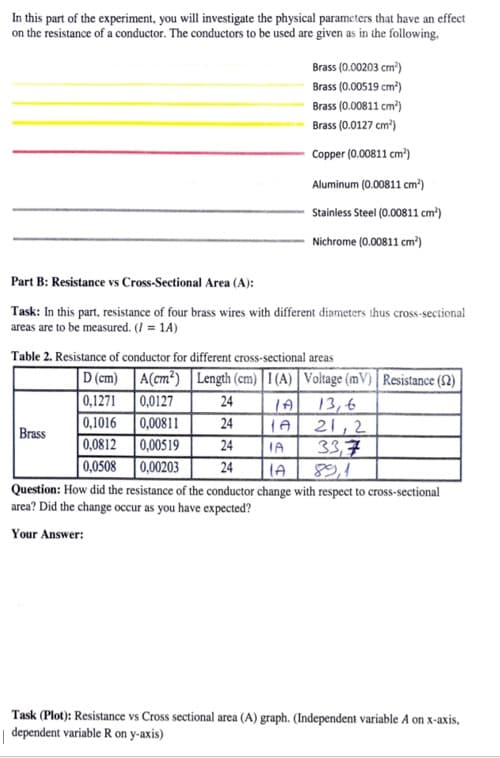can u explane please?
Power System Analysis and Design (MindTap Course List)
6th Edition
ISBN:9781305632134
Author:J. Duncan Glover, Thomas Overbye, Mulukutla S. Sarma
Publisher:J. Duncan Glover, Thomas Overbye, Mulukutla S. Sarma
Chapter4: Transmission Line Parameters
Section: Chapter Questions
Problem 4.4P: One thousand circular mils or 1 kcmil is sometimes designated by the abbreviation MCM75C. Data for...
Related questions
Question
100%
can u explane please?

Transcribed Image Text:In this part of the experiment, you will investigate the physical parameters that have an effect
on the resistance of a conductor. The conductors to be used are given as in the following,
Brass (0.00203 cm")
Brass (0.00519 cm")
Brass (0.00811 cm?)
Brass (0.0127 cm)
Copper (0.00811 cm')
Aluminum (0.00811 cm)
Stainless Steel (0.00811 cm³)
Nichrome (0.00811 cm')
Part B: Resistance vs Cross-Sectional Area (A):
Task: In this part, resistance of four brass wires with different diameters thus cross-sectional
areas are to be measured. (I = 1A)
Table 2. Resistance of conductor for different cross-sectional areas
D (cm) A(cm?) Length (cm)| 1 (A) Voitage (mV) | Resistance (SN)
0,0127
0,1271
0,1016
0,00811
0,0812
0,00519
0,0508 0,00203
24
13,6
21,2
33,7
24
Brass
24
IA
24
IA
Question: How did the resistance of the conductor change with respect to cross-sectional
area? Did the change occur as you have expected?
Your Answer:
Task (Plot): Resistance vs Cross sectional area (A) graph. (Independent variable A on x-axis,
| dependent variable R on y-axis)
Expert Solution
This question has been solved!
Explore an expertly crafted, step-by-step solution for a thorough understanding of key concepts.
Step by step
Solved in 2 steps

Knowledge Booster
Learn more about
Need a deep-dive on the concept behind this application? Look no further. Learn more about this topic, electrical-engineering and related others by exploring similar questions and additional content below.Recommended textbooks for you

Power System Analysis and Design (MindTap Course …
Electrical Engineering
ISBN:
9781305632134
Author:
J. Duncan Glover, Thomas Overbye, Mulukutla S. Sarma
Publisher:
Cengage Learning

Power System Analysis and Design (MindTap Course …
Electrical Engineering
ISBN:
9781305632134
Author:
J. Duncan Glover, Thomas Overbye, Mulukutla S. Sarma
Publisher:
Cengage Learning